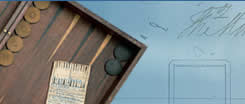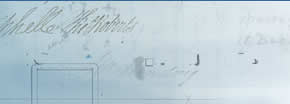| Essay: Flinders and the voyage of the 'Investigator', 1801-03 |
 |
| | | | |
|
|
|
|
Contents
Australia in 1800
The voyage
Matthew Flinders, captain
Robert Brown, naturalist
Ferdinand Bauer, botanical artist
William Westall, landscape painter
HMS 'Investigator'
Chart-making methods
|
|
Australia in 1800
In 1800 vast areas of Australia's coastline were still completely unknown. Dutch navigators had mapped some of the north and west coasts of the land they called New Holland, James Cook had charted the east coast in 1771 and Britain had established the first convict colony in modern-day Sydney in 1788. But little was known of the coastline in between, and virtually nothing about the interior of this huge continent.
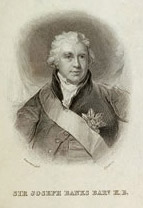 Sir Joseph Banks Bart K.B.
Sir Joseph Banks Bart K.B. |
|
In 1798 the naturalist Sir Joseph Banks, who as a young man had sailed up the east coast of Australia with Captain Cook, asked the British Admiralty to fund an expedition to 'Terra Australis'. The voyage of science and exploration would have two main aims: to provide an accurate chart of the Australian coastline, which would be of great benefit to shipping; and to study the plant and animal life of Britain's newest colony, which could have important commercial possibilities. The Admiralty agreed and ordered a ship, the 'Investigator', to be made ready and, at the suggestion of Sir Joseph Banks, appointed a young lieutenant named Matthew Flinders as the commander of the expedition. |
The voyage
The 'Investigator' arrived at Cape Leeuwin on the south-west tip of Australia on December 6 1801. They sailed along the south coast of Australia, through Bass Strait between Tasmania and the mainland of Australia, reaching Port Jackson (Sydney) in May 1802. On this leg of the voyage they met a French expedition commanded by Nicholas Baudin, which was also engaged in surveying the coast of Australia. From Port Jackson, the 'Investigator' sailed north and became the first vessel to complete a circumnavigation of Australia when it returned to Port Jackson in June 1803.
The ship was condemned on its return Port Jackson as it was leaking dangerously and a replacement vessel, the 'Porpoise', was given to Flinders to complete the voyage. This was wrecked on the Great Barrier Reef in August 1803. A large number of plant specimens collected by Robert Brown during the voyage were destroyed in the shipwreck, but no lives were lost.
Once his crew were safely back in Port Jackson, Flinders took passage to London in the Cumberland to try and get yet another vessel to complete his survey of Australia. During the voyage, Flinders was captured by the French in Mauritius and was held captive there for six years.
The scientific work carried out by the naturalists was of a high quality: their observations of the flora and fauna in the Gulf of Carpentaria, for example, have never been bettered and seldom equalled. While Flinders was not able to finish the massive task of charting the whole of Australia, the large number of coastal surveys he did complete were to a high standard and of great benefit in the growing trade with and British settlement of Australia.
|
|
| |
Matthew Flinders, captain
Flinders was 27 years old when he got command of the 'Investigator'. He had served as a midshipman with Captain Bligh on the second breadfruit voyage to Tahiti in 1791, and showed an aptitude for chart making. He returned to the Pacific on the 'Reliance', which was one of a convoy of ships sent to resupply Britain's convict colony at Port Jackson. Flinders and a friend named George Bass surveyed the coast near to Port Jackson in a tiny 8ft sailing boat named 'Tom Thumb'. | | 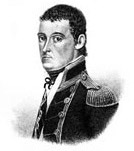 Matthew Flinders, R.N.
Matthew Flinders, R.N.
|
Flinders wrote to Sir Joseph Banks proposing a voyage to make a full and accurate chart of Australia, although Banks had already had the same idea himself. Banks had no official position in the Navy, but he was a naturalist of great standing who had considerable influence with King George III and the Admiralty.
While Flinders was waiting for the 'Investigator' to be fitted out he married his childhood sweetheart, Ann Chappelle. Flinders had a passionate nature (he caught venereal disease twice in Tahiti) and was very much in love with his new wife. He hatched the plan of taking her with him on the voyage to Australia, but the plan was discovered and stopped and once 'Investigator' sailed Matthew and Anne did not see each other until Flinders' delayed return in 1809.
Robert Brown, naturalist
Brown was appointed the senior scientist on board 'Investigator' at a salary of 400 guineas (£420) pa. He had a particular interest in botany but was at that time an army surgeon and Joseph Banks had to use all his influence to get him released for the voyage at a time that Britain was at war with France. Banks's first choice as naturalist had been Mungo Park, the famous explorer, but he had turned down the offer because of a love affair.
Brown collected nearly 4000 specimens during the voyage. He managed to keep some plants alive in a specially built greenhouse that was erected on the deck of the 'Investigator', but most were sent back to Britain as dried specimens.
Once Brown reached Britain in 1805 he began the long process of cataloguing his collection. He finally managed to catalogue 4,200 distinct species of Australian plants.
Ferdinand Bauer, botanical artist
The botanical artist was a key appointment as he would be responsible for drawing the plants and animals that were collected on the voyage. His salary was 300 guineas (£315) pa. Bauer was extremely talented and hard working. During the voyage he made over 2000 sketches of Australia's flora and fauna, Flinders describing him as 'indefatigable & that considering his minute accuracy the number of drawings he has made is astonishing.' He did not carry enough paints with him to make colour sketches, but made up a chart of over 1000 numbered shades; Bauer would then note the number of the colour closest to the original he was sketching.
Because many of the actual specimens were destroyed in a shipwreck, Bauer's drawings were for many years the only surviving records of much of Australian's unique plant life. His drawing of the duckbilled platypus was at first taken to be a hoax as it looked as though a duck's beak had been superimposed on a mole's body.
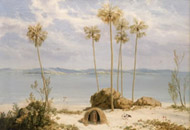
View of Sir Edward Pellew's Group, William Westall
|
|
William Westall, landscape painter
Westall was only nineteen when he was appointed and appeared to be less hardworking than his artistic colleague, Ferdinand Bauer. Flinders summed him up in a letter to his wife saying that 'My messmates improve upon acquaintance; even young Mr Westall, though his foolish days are not yet passed.' |
| |
|
HMS 'Investigator'
The 'Investigator' was built in Sunderland in 1795 and started life as a collier called the 'Fram'. It was bought by the Royal Navy and renamed 'Xenophon', being renamed 'Investigator' when selected for the voyage to Australia in 1800. Colliers were often used for exploration as they had relatively shallow drafts and lots of space for stores. The plan shows the changes that were made to the 'Investigator' to prepare for the voyage: cabins were built for the scientists and a plant cabin was built on the upper deck to take Robert Brown's botanical specimens. | |
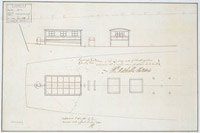
 Ship plans of the 'Investigator'
Ship plans of the 'Investigator'
|
| |
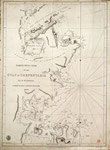
North west side of the Gulf of Carpentaria, Flinders
|
|
Chart-making methods
Flinders largely used the method known as the Running Survey (which had been first used by Captain Cook) to chart the Australian coastline. He would take a series of bearings on fixed points on shore, relating them to the ship's position and speed through the water. It provided an accurate picture of the coastline, but there was rarely enough time to measure the depth of the water in any great detail. In places where the 'Investigator' stopped for any length of time, the surveying is noticeably more accurate.
|
| |
|
|
|
|
|
|
 |
|
